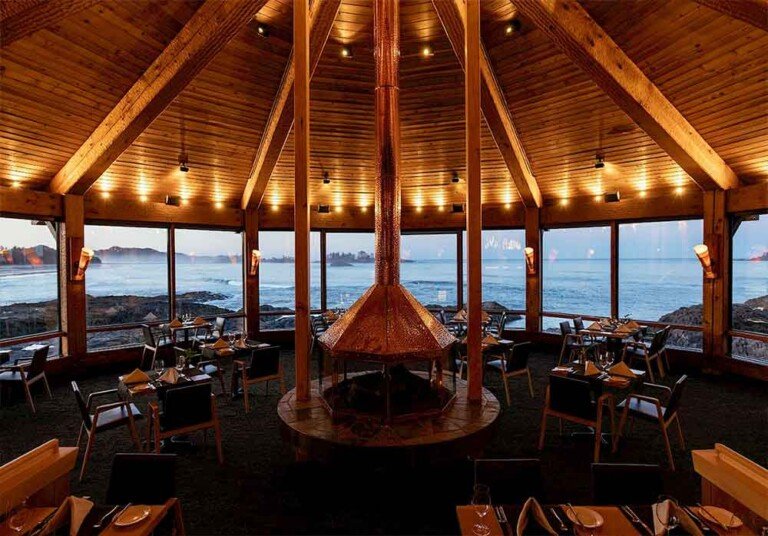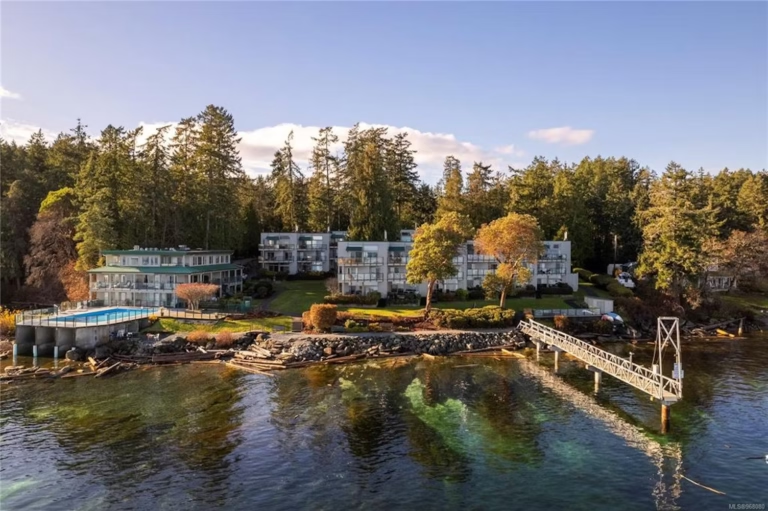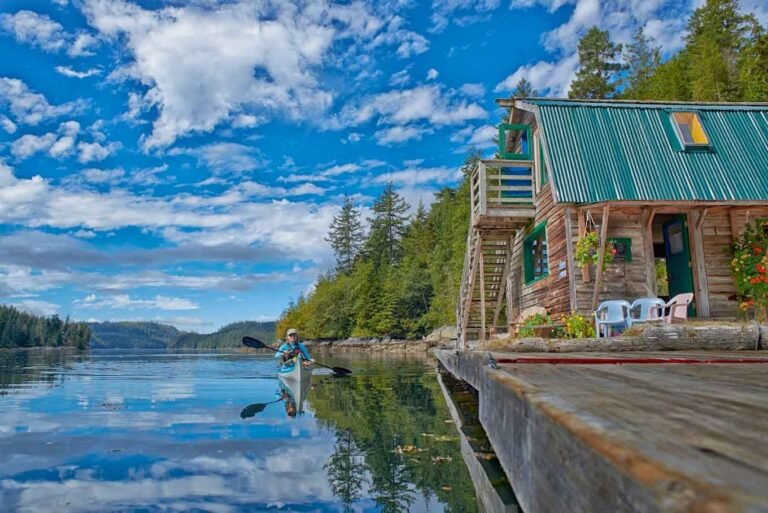Premier Listings for Gwaii Haanas National Park
They lie on the edge of the province’s collective memory like a dream scarce remembered; mythical and elusive, full of meaning and great beauty, yet incomprehensible to the waking mind. Impossible not to marvel at, and revel in, this is Haida Gwaii, the former Queen Charlotte Islands of British Columbia, arguably one of the most beautiful and diverse landscapes in the world. The islands are the ancestral home of the Haida – the West Coast First Nations who have lived here for thousands of years.
Gwaii Haanas National Park Reserve and Haida Heritage Site, a remote collection of 138 islands in the southern part of Haida Gwaii (Queen Charlotte Islands), was established in 1988 amidst a tense confrontation that divided the island’s population, as well as public opinion across Canada and around the world. There are perhaps only 6,000 permanent residents in Haida Gwaii, but 3 million people pledged their support to see logging stopped in this area. At the height of the confrontation, 72 Haida were arrested and charged with criminal contempt of court, an act that shocked the international community. In a gesture of good faith, the Canadian government passed a resolution to support the Haida’s wishes, and Gwaii Haanas was formed.
The park – the place of wonder – is an untamed wilderness with no roads and limited facilities. The San Christoval Mountains dominate the area at an elevation of 1,123 m. Access to the park is by boat or chartered aircraft only. Here one may glimpse a part of the Haida’s ancestral history in the numerous old villages of carved totem poles and longhouses still intact amidst enormous moss-clad trees. The names: T’anuu, K’una (Skedans); where artist Emily Carr captured the spirit of the Rainforest villages in her glorious paintings, Hik’yaah (Windy Bay), Gundl’kiin (Hotspring Island); where the visitor can relax in one of several hot springs pools, and Skung Gwaii (Anthony Island) reflect their ancient beginnings. In the remote southern half of the park Skung Gwaii (village of Nunsting) is an UNESCO World Heritage Site with the largest collection of standing totem poles in their original location in North America.
Note: Following the 7.7 magnitude earthquake that rocked Haida Gwaii on Saturday October 27, 2012, the three hotspring pools commonly accessed by visitors to Hot Spring Island, or Gandll K’in Gwaayaay, went cold and empty. The shifting tectonic plates and reorganization of stress had evidently affected the pathways the water took to the surface. The good news is that the hot water is back again.
Travel arrangements to Gwaii Haanas should be made with a licensed tour operator, and up to 25 commercial operators are licensed for the park reserve. Reservations are required for independent travel in Gwaii Haanas – call 1-800-435-5622.
If you choose to travel independently you are advised to be highly skilled in marine and wilderness travel. There is a cap on the number of visitors entering Gwaii Haanas each day, and if you choose NOT to make an advance reservation, there are only 6 stand-by spaces available each day on a ‘first come, first served’ basis.
There is a 60-minute compulsory orientation session for all visitors prior to entry to the park reserve. No reservations are required for regularly scheduled orientations at the Haida Heritage Centre at Kaay Llnagaay in Skidegate. For the current orientation schedule visit the Gwaii Haanas website at www.pc.gc.ca/gwaiihaanas or call 250-559-8818.
Gorgeous and varied landscape, camping on white sandy beaches, pools of clear tepid water, rich fishing grounds and meandering rivers and estuaries make the Haida Gwaii islands a paradise for the outdoor enthusiast. Topping it all is the rich culture and history of these islands that is alive in the old settlements and present day art of the Haida people.
Native Heritage
Among the hundreds of Haida sites in the park are the remains of SGang Gwaay (Ninstints on Anthony Island), which was declared a World Heritage Site by UNESCO in 1981. The village site of SGang Gwaay ‘llnagaay on this island is considered to have the world’s finest examples of Haida mortuary poles – all more than a hundred years old. Visits to the basecamps staffed by Haida Gwaii Watchmen at key cultural and natural features in Gwaii Haanas provide a face-to-face encounter with the living Haida culture. For most visitors, it is the spiritual aspect of these sites which echoes in them long after they’ve gone home.
The Haida Gwaii Watchmen serve as site guardians and hosts in Gwaii Haanas. Base camps are located at SGang Gwaay (Anthony Island), Gandll K’in Gwaayaay (Hotspring Island), T’anuu ‘llnagaayu (Tanu), and Hlk’yaah GaawGa (Windy Bay). They are open from June 1 to September 15.
Wildlife
Haida Gwaii is rich in wildlife in the sky and sea, and on the ground, and Gwaii Haanas harbours around 39 species of plants and animals not found anywhere else on the planet. Among the native species, expect to see black bears and river otters, birds such as bald eagles, Steller’s jays, and peregrine falcons, and all kinds of ocean creatures, from grey and killer whales to jellyfish and starfish.
One of the best places to see the latter is in Burnaby Narrows on the east side of Moresby Island, accessible only by boat from Moresby camp. Also known as Dolomite Narrows, the waterway connects Juan Perez Sound with Skincuttle Inlet. The narrows are about half a mile (1 km) long, about 160 feet (50 m) wide, and quite shallow, especially at low tide. The bottom is coloured with a cornucopia of sea life: starfish, sea urchins, moon snails, clams, needlefish, sea cucumbers, sea blubbers, red crab . . . the list goes on and on. Because of the high nutrient content in the water, the aquatic life is almost impossibly large and vibrant. From a kayak or other small boat the viewing is good; with a mask and snorkel, it’s even better. At low tide it is possible to walk along the shore, but as this can’t be done without treading on delicate life forms, it is discouraged.
It can be reached only by boat or plane, but nothing is more idyllic than relaxing in a hot spring on Hotspring Island and watching a pod of orcas swim past. Killer whales, or orcas, are often sighted in the Juan Perez Sound region. Best time for whale watching is late spring and early summer. Eagles are a common sight, as are dozens of other birds scattered about the islands. Fully one third of the province’s sea lion population calls Haida Gwaii home. A large colony hauls up on a string of islands called the Kerouards, a water-access-only site at the southernmost tip of Haida Gwaii. All manner of seabirds, including the horned puffin, can also be seen. Visitors in this area can never be sure what manner of creature will show up. A pod of orcas, a grey or a humpbacked whale, or perhaps a gang of Dall’s porpoises, numbering up to 300 strong, may escort you as you sail or paddle along in the southern section of Gwaii Haanas.
Other wildlife viewing spots include the ecological reserves of East Copper Island and Rankine Island, Cape Fanny at the southern tip of Gwaii Haanas, and Puffin Cove on Puffin Island.
Kayaking
The kayak is a boon to the free spirit. It offers flexibility and mobility to the person who doesn’t wish to be hampered by destination-driven travel schedules or a timetable other than the rhythm of the tides. Such is the lure of kayaking around Haida Gwaii. What need is there of a specific destination where every place is as magical as the next, save those coastlines ravaged by logging? The entire cluster of islands has been circumnavigated by kayak, and is open to the seafaring explorer. That said, Gwaii Haanas is by far the most popular kayaking playground, with such destinations as Hotspring Island, Burnaby Narrows, Windy Bay, Anthony Island (Ninstints), Tanu, All Alone Stone, Rose Harbour, St. James Island, Flatrock Island, Echo Harbour . . . the list goes on and on.
The west coast of Moresby Island is steep and rocky with pounding surf and lengthy stretches of coast where landing is impossible or very difficult. It is not recommended for kayakers. The east side, with its range of islands, islets and inlets offers more options for alternate routes during changing weather conditions and more sheltered route choices if an exposed route becomes too dangerous. The east coast is still a challenging area to paddle and getting to destinations such as Hlk’yaah GaawGa (Windy Bay) and Gandll K’in Gwaayaay (Hotspring Island) involves exposed crossings and hazardous stretches of coastline and headlands.
Tide tables are essential for exploring Gwaii Haanas. Booklets published annually by the Hydrographic Service provide instructions on the use of tables to determine daily tides (time and height) for specific locations. For Haida Gwaii you should obtain: Canadian Tide & Current Tables Volume 6 (current year), “Barkley Sound and Discovery Passage to Dixon Entrance” (available from Supply and Services Canada). The “Coastal Pilot” also contains useful local information on tides. For more detailed information, consult a knowledgeable local mariner or the Coast Guard Auxiliary.
Many visitors to Gwaii Haanas travel with organized tour groups. Commercial operators offer services in Gwaii Haanas from May through September. Services include guided tours, charter vessel services, passenger and cargo transport between points. A popular way to kayak this wonderland is from the comfort and security of a kayak mothership. Paddlers return to the warm, comfortable vessel to enjoy hot showers, good food, and comfortable beds, setting out the next day to further explore the islands. There is considerable range in the size, nature and price of the kayaking services to the park. It is advisable to make reservations well in advance of your trip. Only licensed commercial operators may provide services in Gwaii Haanas National Park Reserve and Haida Heritage Site.
Boat launch facilities closest to Gwaii Haanas are at Moresby Camp on Cumshewa Inlet. Moresby Camp is a private industrial site, accessible by logging road.
Visitors launching sea kayaks or small boats at Moresby Camp can travel the relatively protected inside waters of Carmichael Pass south to Gwaii Haanas. Travelling time by kayak from Moresby Camp to the northern boundary of Gwaii Haanas is approximately 2 days, weather permitting. You could spend months, even years, exploring the coasts in Gwaii Haanas, stopping to investigate the many onshore and inland attractions, and still not feel that you knew the place. But that’s part of the magic and appeal of Haida Gwaii.
Camping
Random camping is the rule in Gwaii Haanas. There are no designated campsites within Gwaii Haanas – you camp where you please, preferably on sand or stone, or wherever else you will have as little impact as possible. Camping is not permitted at T’anuu Village, or on Gandla’kin (Hotspring), Ata Naa (House), Copper, Jeffrey, Rankine, or Skung Gwaii (Anthony) Islands, or Slug Islet. These areas are particularly sensitive cultural sites or important bird-nesting areas. If in doubt, ask at any of the Watchmen base camps. There is no camping at any Haida Gwaii Watchmen site in the park except for Windy Bay, or Hik’yaah, where the stand against logging was taken by the Haida Nation back in the 1980s.
Hiking
There are no designated or maintained hiking trails in Gwaii Haanas. All hiking is of the “bushwhacking” variety. It is easy to get lost due to fog, and density of forest. Hikers should have excellent compass skills and use map and compass at all times.
Weather
The climate of the islands is typical of British Columbia’s outer west coast – cool and wet virtually any time of the year. The driest months are usually May, June, and July and usually, the best weather is between mid-June and mid-August. The rainy season can begin as early as mid-August. The east side of the islands is considerably drier than the west, which can receive between 500 and 800 centimetres of rain a year.
Northwest and westerly winds prevail in summer and can blow strongly for lengthy periods. These winds funnel over the islands and down inlets of the east coast creating gusty conditions that can be a hazard especially for kayaks. Storms associated with frontal systems hammer the islands from the southeast and southwest. These occur frequently in winter, and are not uncommon in the summer months. Build enough time in your travel plans to include days of being “weathered in.”
If you are not travelling with a guide or guided tour, file a trip plan with the Canadian Coast Guard in Prince Rupert. Call collect, 250-627-3082. Be sure to contact them as soon as you return. If you don’t, you may be held responsible for any unnecessary search and rescue initiated on your behalf.
Information
Visitor Centres are located in the Sandspit Airport and in the village of Queen Charlotte City on Wharf Street. Both centres have a trip planning area with marine charts and topographic maps to assist you in planning your route, and a marine VHF radio to check the weather and sea conditions. The centres operate from May 1 to September 30.
For a free Gwaii Haanas information package contact: Gwaii Haanas National Park Reserve and Haida Heritage Site, P.O. Box 37, Queen Charlotte, BC, phone 250-559-8818, email gwaii.haanas@pc.gc.ca or visit www.pc.gc.ca/gwaiihaanas
The Gwaii Haanas National Park Reserve and Haida Heritage Site office is located at the new Haida Heritage Centre, 60 Second Beach Road, Skidegate.
The office is open Monday to Friday 8 a.m. to noon, and 1 p.m. to 4:30 p.m.
The only private commercial facilities in the park are located at Rose Harbour, a former whaling station, located on the north coast of Kunghit Island. Bed and Breakfast accommodation and boat transportation is provided.
Getting to Haida Gwaii (Queen Charlotte Islands)
There are only 120 kms of paved roads in Haida Gwaii, and the cost of transporting your car on the ferry is high, so you could consider leaving your car behind and letting boats, foot, or taxi be your mode of transport.
Paved Highway 16 serves the two main islands, running from Sandspit to Alliford Bay on Moresby Island, continuing from Skidegate to Masset and Old Masset on Graham Island (71 miles/113 kms). Alliford Bay and Skidegate are connected by a ferry across Skidegate Inlet. On the way, the highway passess through Port Clements, Tlell, and Queen Charlotte City, the navel of Haida Gwaii. The logging companies have extensive road systems, principally in the plateau areas from Juskatla to Moresby, with a private road connecting Juskatla with Port Clements. Across Skidegate Inlet on Moresby Island, a logging road runs 40 kms south from Alliford Bay to Moresby Camp, or via Sandspit and Gray Bay, the first 15 kilometres of which are paved.
From Vancouver: The Haida Gwaii islands are northwest of Vancouver, about 770 km by air. Year-round air service is available from Vancouver International Airport to Sandspit.
From Prince Rupert: Take the six to eight-hour ferry crossing from Prince Rupert to the BC Ferry: Prince Rupert/Queen Charlotte Islands on Graham Island (93 miles/135 km). BC Ferries operates 6 round-trip sailings per week during the summer months, and 3 weekly round-trips in winter. Reservations are strongly recommended. You can also fly from Prince Rupert to Sandspit on Moresby Island.
Getting to Prince Rupert
Drive the Yellowhead Highway 16 from Prince George to Prince Rupert
Travel by VIA Rail to Prince Rupert
Sail with BC Ferries to Prince Rupert, from Port Hardy, on Vancouver Island
Alaska State Ferry to Prince Rupert from Alaska
Getting to Gwaii Haanas National Park Reserve and Haida Heritage Site:
Floatplane access to Gwaii Haanas National Park Reserve and Haida Heritage Site is from Queen Charlotte City. The closest road access to the park is at Moresby Camp, from where visitors can reach the park by boat or kayak. The nearest boundary of the park is 30 miles (50 km) from Moresby Camp.
Nearby Regions & Towns
Park Notices
More Information
Parks Canada – British Columbia
Website: www.pc.gc.ca
Premier Listings

Biographical Info
Ocean Light Adventures introduces their new vessel for summer 2021. The powerboat Afterglow is a 60ft Monk designed Gulf Commander with 5 staterooms and 3 heads, offering amazing wildlife viewing from all windows and from the spacious top deck. Her crew has 34 years of experience offering natural history and photography tours on the BC Coast, including Haida Gwaii, and specializing in grizzly viewing tours in the Khutzeymateen Grizzly Bear Sanctuary, and spirit bear and grizzly tours in the Great Bear Rainforest. We also offer whale watching and eco tours, from totems to intertidal treasures, rocky shores to sandy beaches, and spawning salmon to towering trees. We offer five spectacular adventure trips between May and October, each to a different region and each highlighting the awe-inspiring beauty of the beautiful BC coast.

Biographical Info
Explore BC and Southeast Alaska with Bluewater Adventures aboard our 70′ yachts sailing the BC Inside Passage, the Queen Charlotte Islands, Gwaii Haanas National Park, the Great Bear Rainforest, and Vancouver Island. You’ll see whales, Grizzly, Black and Kermode bears, and experience ancient native villages and Haida culture, primeval forests, wilderness, and amazing coastal wildlife.





